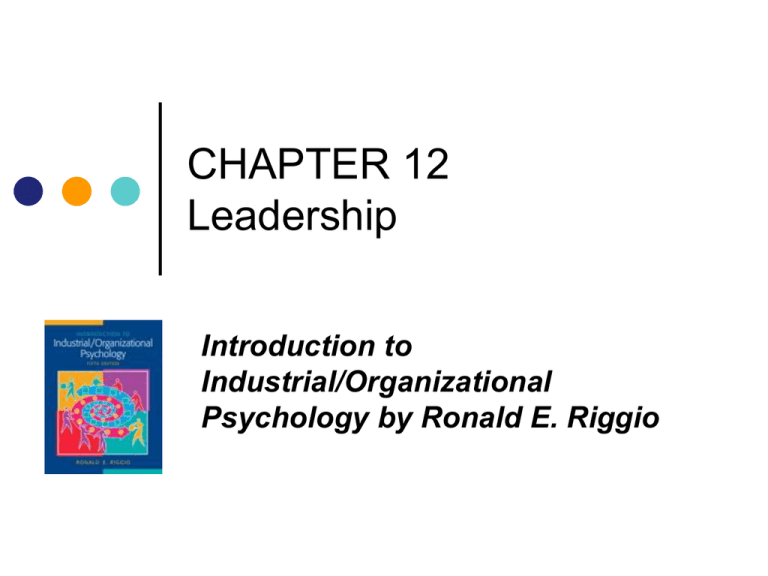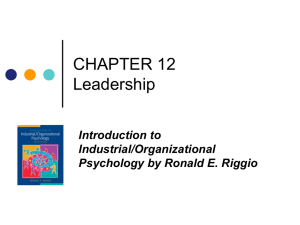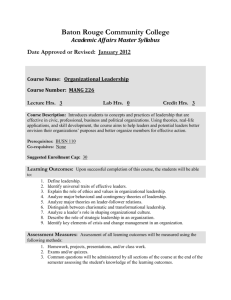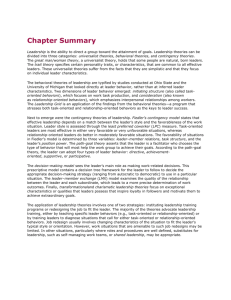Leadership
advertisement

CHAPTER 12 Leadership Introduction to Industrial/Organizational Psychology by Ronald E. Riggio What is Leadership? Leadership is the ability to guide a group toward the achievement of goals. Leaders can be formally recognized by the organization, or individuals can emerge as informal leaders within work groups because they have some characteristic that the group members value. Universalist Theories of Leadership Universalist theories look for the major characteristics common to all effective leaders. Great man/woman theory maintains that great leaders are born, not made. Trait theory attempts to discover the traits shared by all effective leaders. Traits are enduring attributes associated with an individual’s personality or makeup. Universalist Theories of Leadership Research indicates that extraversion, conscientiousness, openness to experience, agreeableness, and emotional stability, in combination, are associated with effective leadership (Bono and Judge, 2004 in Riggio 2009). Possession of flexibility, charisma, and social intelligence are also important for leadership (Riggio, 1986). The major problem with the original trait approach is that it was too general. Behavioral Theories of Leadership Behavioral leadership theories (derived from Ohio State and University of Michigan studies) focus on the behaviors common to effective leaders. The Ohio State Leadership Studies identified two important leader behaviors: • Initiating structure (defining, organizing, structuring the work situation). • Consideration (showing concern for feelings and needs of followers). Behavioral Theories of Leadership The University of Michigan Leadership Studies also identified two important leader behaviors. • In task-orientated behaviors, leader behaviors focused on the work task. • In relationship-oriented behaviors, leader behaviors focused on maintaining interpersonal relationships on the job. Both types of behaviors have been linked to effective leadership. Contingency Theories of Leadership Fiedler’s contingency model maintains that effective leadership depends on a match between the leader’s style and the degree to which the work situation gives control and influence to the leader. According to Fiedler, leaders may be primarily task-oriented, or primarily relationship-oriented. Contingency Theories of Leadership To assess leaders’ task or relationship orientation, leaders use the Least Preferred Coworker (LPC) scale to rate their most difficult follower. • Persons who give their least preferred coworkers very harsh ratings (low LPC scores) are task-oriented leaders. • Persons who rate their least preferred coworker somewhat leniently (higher LPC scores) are considered to be relationshiporiented. Contingency Theories of Leadership In Fiedler’s model, to assess the work situation, three variables are examined. • Leader-member relations refers to the quality of the relationship between leader and followers. • Task structure is an assessment of how well elements of the work task are structured. • Position power is a leader’s authority to punish or reward. Contingency Theories of Leadership According to Fiedler, task-oriented leaders are successful in very unfavorable situations (where leader-member relations are poor, the task is unstructured, and the leader has weak position power) because of their takecharge style. Task-oriented leaders are also effective in very favorable situations because they encourage high productivity. Relationship-oriented leaders are most effective when their situational control and influence are neither very high nor low. Contingency Theories of Leadership The path-goal theory states that a leader’s job is to help the work group achieve their desired goals, using one of four categories of behavior. • Directive behavior provides instructions and suggestions for job performance. • Achievement-oriented behavior concentrates on particular work outcomes. • Supportive behavior shows concern for workers’ well-being. • Participative behavior encourages members to assume active roles in planning and decision making. Contingency Theories of Leadership The Decision-making model is a theory that matches characteristics of the situation with leader decisionmaking strategies. The theory provides different decisionmaking strategies. The theory predicts proper leader behavior in making decisions and gives “prescriptions” for the decision maker to follow. Contingency Theories of Leadership The leader-member exchange model asserts that effective leadership is determined by the quality of the interaction between leaders and particular group members. Leader-member exchange can range from low quality to high quality. With high quality leader-member exchange, there is frequent, positive communication between leaders and members. Charismatic and Transformational Leadership Theories Charismatic leadership theory states that leaders possess some exceptional characteristics that cause followers to be loyal and inspired. Charismatic leaders communicate shared group goals and convey confidence in their own abilities and those of followers. Charismatic leaders are most effective when goals are unclear and situational conditions are unstable. Some researchers suggest that charismatic leaders possess exceptionally high-quality social skills and an ability to inspire followers at a deep emotional level (Riggio, 1987). Charismatic and Transformational Leadership Theories Transformational leadership focuses on the leader’s ability to provide shared values and a vision for the future of the work group. There are four components of transformational leadership. • Idealized influence: the transformational leader is a positive role model. • Inspirational motivation: the leader inspires followers by providing a compelling vision of a positive future. • Intellectual stimulation: followers’ curiosity and creativity are stimulated and challenged. • Individualized consideration: the leader pays personal attention to each member’s needs and concerns. Applications of Leadership Theories Leadership training can follow two general approaches. Teaching leaders diagnostic skills for assessing situations to determine types of leader behaviors that work best. Teaching leaders specific skills or behaviors that they lack. A combination of both approaches is likely to be most effective. Applications of Leadership Theories Research in redesigning jobs indicates that leaders may be unnecessary in certain instances, leading to a search for “substitutes for leadership”. This applies to: Job enrichment groups. Groups where all members have equal status and high skills/abilties. Work tasks that are well-structured and intrinsically satisfying to workers. Shared leadership, where leadership is shared among the group members rather than being centralized in one person.






